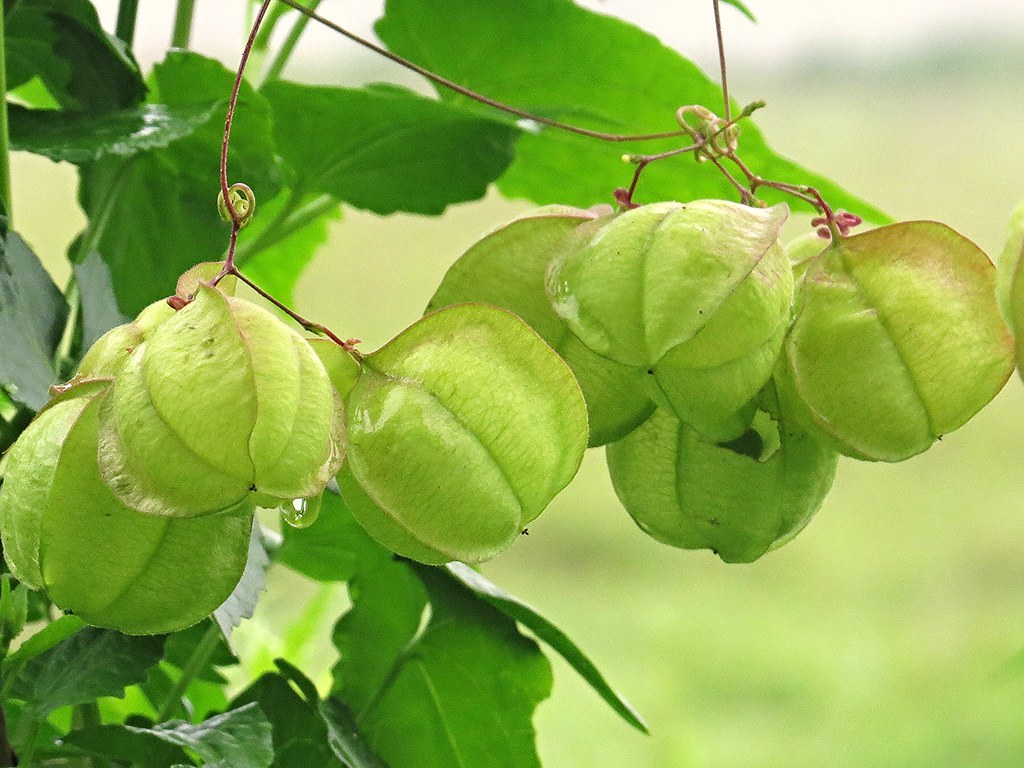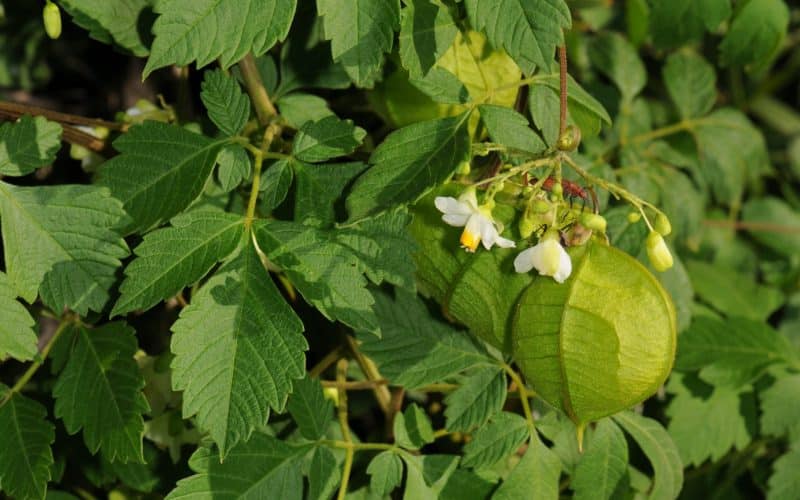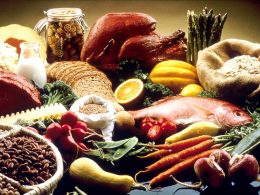Cardiospermum halicacabum known widely as Balloon vine is a deciduous plant that belongs to soapberry family Sapindaceae. This plant is peculiar to Africa, the Caribbean, and tropical South America. It is also cultivated in Burma and the Philippines.
The word Cardiospermum is coined from two Latin words, cardio and Sperma, which means heart and seed, respectively. The seed has a white heart-shaped pattern. Halicacabum is gotten from the Latin word halicacabus, a plant with bloated fruits.
There are also other common names for the balloon vine, such as love-in-a-puff, heart pea, heart seed, blue passionfruit, winter cherry, upland cotton, amongst others. The name balloon vine comes as a result of its production of fruits having the shape of a balloon.
Description
Balloon vine is a deciduous woody, perennial, branchy, and creeping vine that grows up to 10ft (3m) long. The plant is found mostly in floodplains, riverbanks, plantations, gardens, woodland, moist thickets, forest margins, shrublands, and cultivated areas.
This plant grows well on acidic or basic soil. Roots are usually shallow with woody, long taproots. Its stem color changes to pale brown, then thicken and become woody. It also possesses tendrils that can be used for climbing. The leaves are usually hairy and soft, having wide-toothed edges, visible veins on each side, and grows on a hairy stalk.
It has small, white flowers which are about 2.5mm long. It possesses four petals ( two large ones that adhere to the sepals, and two small ones that are distant from the stamen), four sepals (concave, with other ones to be short), eight stamens( eccentric, filament free or united at the base.
The ovary is 3-celled, style 3-fid, and ovule solitary. Tendrils are often located below the flower head. The flowering of the balloon vine usually takes place from July to August. It can flower all through the year except for cases of a long period of drought.
When fertile, a seed capsule emerges, and it is almost spherical. These capsules are bloated, thin-shelled, and angle up to 3cm in diameter. The fruits are green at first but change to light brown once they are matured and ready for harvesting.
When the fruits ripen, it divides into three segments, each bearing a single seed. The seeds are black, smooth, and blur with a white fine permeable heart-shaped spot at the micropyle and measure 5mm in diameter. The fruits are spread out by water current and sometimes by the wind.
Health Benefits of Balloon Vine

The balloon vine plant has a number of health benefits. Below are a few of them:
1. Possess Anti-inflammatory and Antioxidant properties
Balloon vine possesses some excellent anti-inflammatory and antioxidant properties. The presence of phenols, flavonols, and glycosides in balloon vine is responsible for its anti-inflammatory and antioxidant qualities.
It also possesses analgesic properties (pain-relieving properties), making it an effective plant for the reduction of all kinds of inflammation.
2. Can Increase Fertility
The intake of balloon vine boosts sperm count and motility. Regular consumption of balloon vine for 30 days can largely increase sperm count and also boost serum testosterone levels too.
3. Antibacterial properties
Every part of the balloon vine has strong antibacterial properties that are very effective against these strains of bacteria ( Staphylococcus Aureus, E.coli, Pseudomonas, Salmonella, and Aeromonas).
4. Serves As Mosquito Repellent
When applied topically on the skin, balloon vine can repel mosquitoes. The ethanol leaf extract was used in a study, and it effectively repelled mosquito bites of three types of mosquitoes.
5. Promotes hair growth
Balloon vine is also beneficial to the hair as it helps in the treatment of dandruff and itchy scalp, which promotes hair growth. It can be used in preparing a homemade oil to treat dandruff. Boil balloon vine with some sesame oil and use oil to massage the scalp before washing.
6. Anti-Ulcer Benefits
The extract obtained from boiling the leaves of the balloon vine has moderate anti-ulcer properties. Those that suffer from stomach acidity will benefit significantly from incorporating balloon vine to their diet. For the best results, it should be consumed in the form of soup.
7. Possess Anti-Arthritic properties
Balloon vine has been used traditionally to treat arthritis, and this benefit is also backed by research. Balloon vine is regularly administered in the form of dosa or rasam to patients who have arthritis. It helps reduce pain and inflammation.
8. Anti-Diarrheal properties
The water extract from this plant also possesses anti-diarrheal properties due to the presence of alkaloids, tannins, saponins, sterols, flavonoids, and triterpenes in the plant. This has been used as a traditional medicine in certain areas in India.
9. Helps Treat Joint pain
Balloon vine can also be used to ease joint pains temporarily, and it provides fast results. The best way to use balloon vine to relieve joint pain is by making a compress out of it. To make the compress, heat some castor oil in a pan, add the balloon vine leaves, and fry in very low flame. Once it is hot enough, you can now apply to the affected area.
10. Cures Aphtha
Balloon vine has an excellent healing effect on aphtha. For the treatment, fresh balloon vine leaves can be grounded and mixed with edible salt, and then applied to the affected area. It can be administered 1-3 times daily to patients to speed up the healing process as well as relieve pain.
11. Anti-Convulsant Properties
Balloon vine also possesses anti-convulsant properties. Alcohol extract gotten from this plant was tested on rats experiencing electroshock-induced convulsions and it effectively calmed the seizures. The whole plant extract was used, and the dosage given was 350mg/kg of body weight.
12. Cures Furunculosis
In the treatment of furunculosis, balloon vine is a commonly used medicine. At the beginning of the illness, the fresh grass of the balloon vine can be grounded and mixed with a considerable amount of honey to make an ointment for topical application on the affected area. The ointment should be used twice daily; improvement will be noticed after 3-5 days.
13. Anti-fungal properties
Balloon vine also possesses powerful anti-fungal properties. There are two chemical compounds responsible for the anti-fungal activity of balloon vine. They are Rutin and Luteolin.
14. Contain Anti-pyretic properties
Balloon vine is one of the best remedies for the reduction of malaria fever. Anyone suffering from cold, fever, or headache should take a cup of warm balloon vine soup as this will help to lessen the pain and fever considerably.
Traditional benefits of balloon vine include:
- Juice from the leaves has been used in the treatment of earache.
- In Sri Lanka, leaves were used to treat male fertility
- Its extract is also an excellent herbal treatment for cancer
- The mixture gotten after the preparation of its roots is a good cure for hemorrhoids.
- The crushed leaves release a vapor that can be inhaled to relieve headache
- It is used in the treatment of fever, rheumatism, and tumors.
- Root and leaves are used as a treatment for piles, rheumatism, chronic bronchitis, and amenorrhea.
- Tea made from this plant is used to treat itchy skin
- A paste made from its leaves can be applied to the lower abdomen of women post-delivery. It helps remove unwanted products from the uterus.
- Juice extracted from crushed leaves can be applied around the eyes and used as an eye drop to treat sore eyes and cataracts.
- The plant dissolved in some sesame oil can have a therapeutic effect on skin disorders such as varicose veins, scabies, and eczema.
- Fried leaves are applied to the pubis to increase menstrual flow in amenorrhea.
- The leaves can also be boiled in castor oil and used on swellings or tumors. It has a soothing effect on them.
- Its oil also provides relief from dandruff, just prepare and incorporate into your hair routine.
How To Grow Balloon Vine
The seeds of balloon vine should be planted outdoors in an already prepared site. It is important to plant seeds 1/4 inch deep into the soil and should be kept moist until germination.
The average time for germination is 14-21 days, and plant spacing should be 6 inches. Balloon vine requires light and should be given a support-like structure to climb as it overgrows.
Other Interesting Facts About Balloon Vine
- The oil obtained from the seed is edible
- The seeds are attractive and are used as beads.
- The oil from the seed is said to contain antifeedant action on insects and insect repellent properties.
- The leaves were found out to be used for washing the head and clothes.
- The stems of balloon vine are used in making a basket.
References;
- Cardiospermum halicacabum (PROSEA) – PlantUses
- Cardiospermum halicacabum – Wikipedia
- Anticonvulsant activity of alcoholic root extract of Cardiospermum halicacabum – SciELO
- Chemical Constituents and Antimicrobial Activity of Indian Green Leafy Vegetable Cardiospermum halicacabum – NCBI
- Review of beneficial and remedial aspects of Cardiospermum halicacabum L. – academic Journals
- Repellent properties of Cardiospermum halicacabum Linn. (Family: Sapindaceae) plant leaf extracts against three important vector mosquitoes – PubMed









